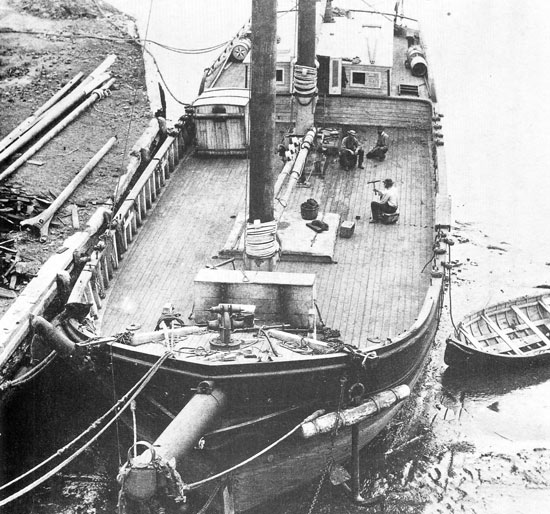B A C K T H E N
Casco Lodge Just After the War

Yarmouth, early ‘70s. The schooner Casco Lodge, officially of Portland but truly of Yarmouth, where she was built in 1867, lying in a mud berth. No doubt she has been laid up for the winter and is now being refitted for another season. Her hemp standing rigging has been sent down, probably to be replaced with iron wire, which was then coming into general use on vessels.
The forward-facing companionway, the angled catheads, the four shrouds per mast per side (small schooners usually had three), and even the bold shape of her bows, are reminiscent of a square-rigger; indeed, Yarmouth was a square-rigged town. David Pierce, her captain and doubtless part owner, may well have been an old square-rigger man. Her managing owner, Captain Perez Blanchard, was a partner in Blanchard Brothers, builders and managing owners of big, full-rigged ships. The Casco Lodge and the 1874 full-rigger C. F. Sargent were the only vessels listed as built by Albert Seabury, but the Seaburys were noted shipbuilders long associated with the Blanchards.
The men are recaulking the deck. Typically, a deck had to be recaulked after four or five years’ service, and a tight deck was in some ways as important as a tight hull. The box-like structure is the “caboose,” which was normally lashed in position abaft the foremast and was a self-contained galley. The horizontal stovepipe is intended to draw on either tack.
Cabooses were customarily built by shops that also built ships’ boats. The stern, or yawl, boat is tied alongside. Of very heavy construction, it shares a familial appearance with its mother ship. The oars are aft, on the cabintop.
The Casco Lodge’s crew was likely composed of captain, mate, cook/steward, sailor, and a boy or two. All slept aft, a democratic arrangement unheard of on larger vessels. The many Yarmouth boys who went “coasting” on schooners in the summer were permitted to attend school during winter months even after reaching “man’s estate,” and often proved a sore trial for school masters, who had best be men of “courage and fine physique.”
The tall anchor-chain locker, ahead of the foremast, was not customary deck furniture—on most small coasters the chain was stowed on deck in low open boxes. Lifting the dirty, heavy chain into this locker as it came off the windlass, and then lifting it back out so as to range it along the deck before anchoring, must have inspired many evil thoughts towards its designer—likely Captain Pierce. Along with the angled fo’c’s’le deck, it was likely devised to maximize space for deck cargoes.
The swiveling patent-winch mounted atop the short fo’c’s’le head was highly unusual, as was the winch at the base of the mainmast. The standard log-type anchor windlass, much like Noah’s, is largely obscured from our view, but one of its “brakes” (or handles) lies on the fo’c’s’le head. Looking aft, decorated water casks line the poop deck. Captain Charles Oakes of Yarmouth recalled:
While the prosperity of the town was based on its shipyards in which a large part of the population was employed, a brisk coasting trade was also carried on. There was an immense barn on Union Wharf where hundreds of bales of hay were stored for shipment and this, with the output of the brickyards, furnished profitable employment for the schooners George and Emily, James Garcelon, Margaret, L. W. Pierce, Ranger, Willie Martin and Casco Lodge, all owned and operated from the town.
In all, eleven or so small schooners were owned at Yarmouth in the ‘70s. They often returned from the westward with hard coal from Philadelphia, Perth Amboy, or New York harbor loading points. An-thracite, primarily for domestic use, was generally brought to New England coastal markets in small schooners.
The Casco Lodge was named in honor of the local Masonic lodge, chartered in 1821, whose first master, George Pierce, was a painter. However, “it was but ten months after he assumed his seat in the east that Worshipful George Pierce was raised to membership of the blissful Lodge above.” The lodge nearly expired as well, due in large part to the protracted absences of the many brethren who were shipmasters.
Text by William H. Bunting from A Days Work, A Sampler of Historic Maine Photographs, 1860–1920, Part II. Published by Tilbury House Publishers, 12 Starr St., Thomaston, Maine. 800-582-1899.
